
Through his fantastic images, Finnish astrophotographer J-P Metsavainio shows how photos can be breathtakingly beautiful when art meets science. One of Metsavainio’s recent images, WR 134 as a Rising Phoenix, is a brilliant example of the aesthetic wonders of the cosmos and the extreme technical precision required to do astrophotography.
Metsavainio’s latest image shows WR 134, a variable Wolf-Rayet star, in exquisite orange and blue detail. WR 134 is located about 6,000 light-years from Earth in the constellation Cygnus.
“It’s surrounded by a faint bubble of glowing ionized oxygen, blown out by the intense radiation and fast solar wind from the star. The star has five times the radius of the sun and it’s 400,000 times more luminous,” the photographer says of WR 134.

Capturing WR 134 like Metsavainio requires a lot of experience, skill, and specialized equipment. While a traditional camera with a star tracker can capture fantastic space photos, a telescope and astronomical image sensor helps artists like Metsavainio take their work further.
While he has used a traditional camera and shorter lenses to photograph WR 134 over the past five years, Metsavainio said it was “time to get closer.” And get closer he did thanks to a Celestron Edge 14″ telescope with a 0.7 focal reducer, mounted to a MesuMount Mark II and attached to an Apogee Alta U9000M camera with an Apogee seven-filter wheel. At this long focal length and when photographing something so far away across multiple different wavelengths, Metsavainio had to do a lot of shooting — he captured a total of 23 hours of exposure.
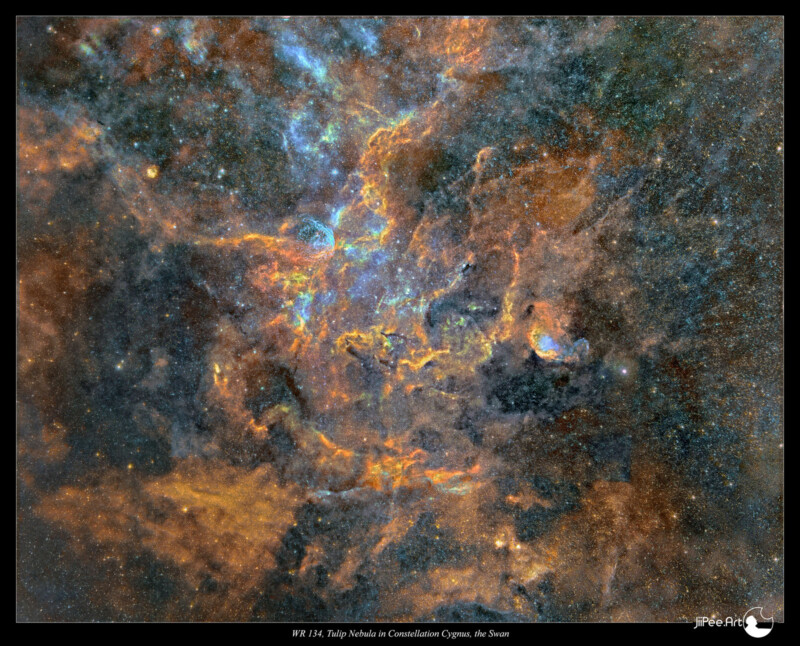
He did 15 separate 20-minute exposures focusing on H-alpha gas emissions (five total hours), 45 20-minute shots filtered for O-III (15 hours), and 20-minute shots looking at S-II wavelengths (three hours).
The photographer stacked and combined all these shots using specialized software before doing color correction and curves adjustments inside Photoshop (Photoshop CS3, as a matter of fact).
“This is a very slow form of imaging,” Metsavainio tells PetaPixel. The meticulous nature of astrophotography extends beyond individual shots, too, as Metsavainio has been working on a grand mosaic of the Milky Way for over a decade, amassing more than 1,500 hours of cumulative exposure time.
Some of this time has been spent using a traditional DSLR with typical lenses. Many amateur astrophotographers get excellent results using “normal” cameras with tripods, but people need star trackers to do work like Metsavainio. The Earth constantly rotates, so the exposure times required for deep space images are too long to keep stars tack sharp.
These days, Metsavainio uses a specialized astronomy camera for his work, which, as he explains, is quite different from a typical DSLR or mirrorless camera.
![]()
“Astronomical cameras usually have a regulated CCD/CMOS sensor cooling system. In my case, the CCD is cooled to -45 degrees centigrade,” the photographer says. “This is important since it cuts down thermal noise and makes image calibration very accurate.”
His specialized camera also captures 16-bit images, whereas a typical interchangeable lens camera captures 12- or 14-bit files, with some occasional exceptions, like with medium-format cameras.
Another huge difference is that astronomical cameras are primarily grayscale cameras using extremely efficient image sensors.
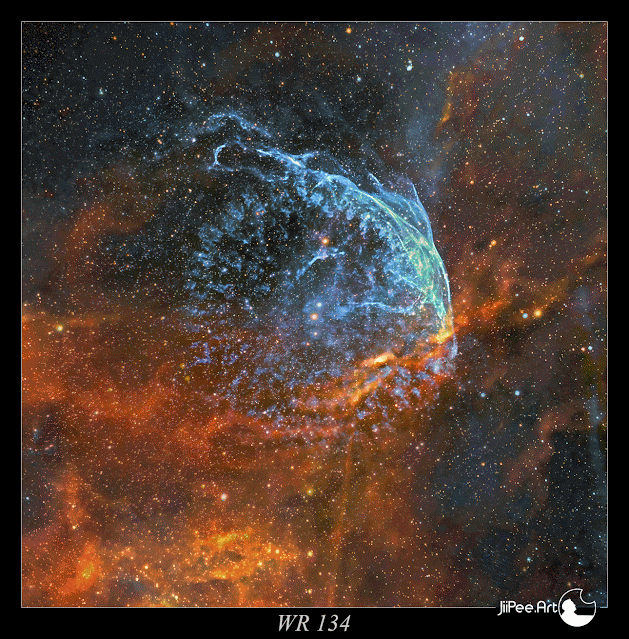
“Astronomical cameras have a very high quantum efficiency. In my camera, it is about 70 percent. Some backlit CCD/CMOS cameras have a QE over 90 percent,” the photographer explains. “QE basically means how many photons out of 100 a camera will capture. It cannot be much higher than 90 percent due to quantum fluctuation. A normal DSLR camera has QE about 20 to 30 percent, mainly due to the Bayer matrix over the imaging chip.”
While a typical camera has a Bayer filter of RGB color filters over the pixels to capture color images, an astronomical camera doesn’t need to worry about that. Since it’s a grayscale camera — all camera sensors are grayscale at the sensor level — the spatial resolution of an astronomical camera is relatively higher. There is no interpolation required, so there is about four times more data than a traditional camera captures, all else equal. Typical cameras also cut out a lot of the most fascinating light in space, like H-alpha light. While specialized services can augment cameras to perform better in this way, it’s something to keep in mind.
Bringing Color to Space
If Metsavainio’s camera is grayscale, how does he create beautiful color images?
“If you want to make a color picture, you must shoot the target at least three times. Usually, the target is shot four times for the following color channels: L=luminance, shot with a clear filter, R (red), G (green), and B (blue).”
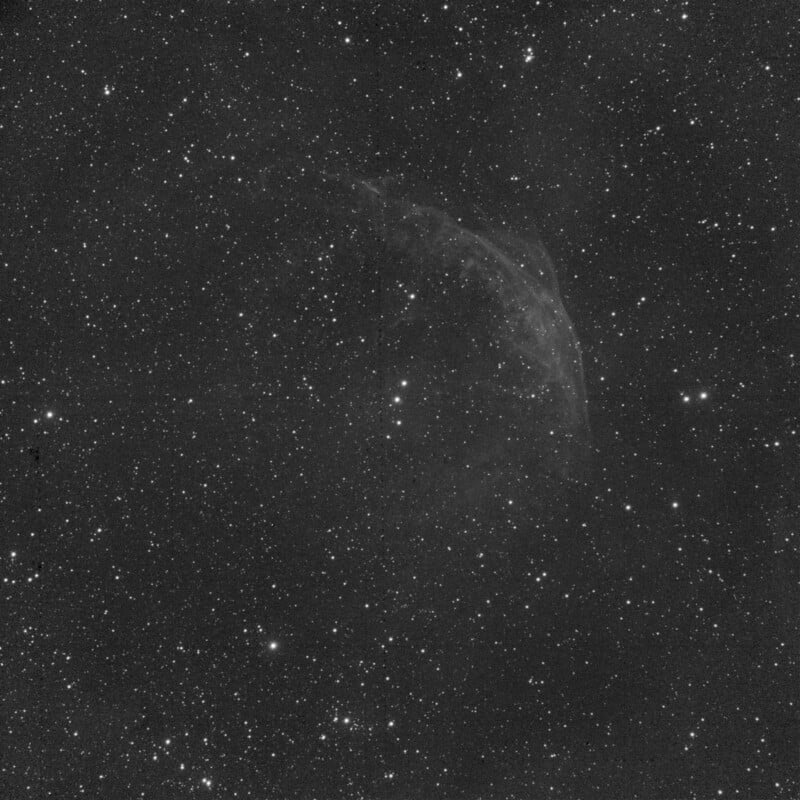
In Metsavainio’s case with WR 134, he does narrowband imaging, so he uses three filters for different emission lines for light emitted by various ionized elements.
“Due to the intense light pollution in my location, I have concentrated to a narrowband imaging. It’s a visible light emitted by emission nebulae. nebulae are way too large to be lit by the starlight, hundreds and thousands of light-years across, but the elements in the gas cloud get ionized by the radiation from the stars. Ionized elements start then emit light with a typical color to each element. The emitted light has a very specific wavelength in each element,” Metsavainio says.
Common emission lines in nebulae include hydrogen, sulfur, and oxygen (H-alpha, S-II, and O-III). These colors are deep red, red, and turquoise to the human eye.
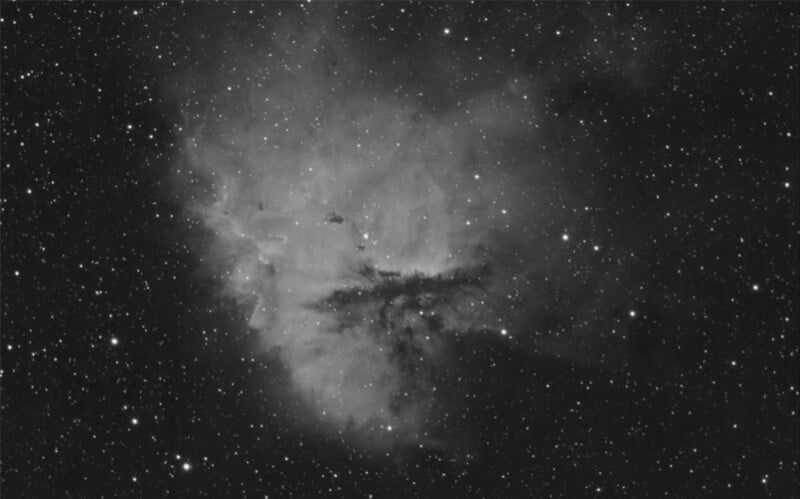
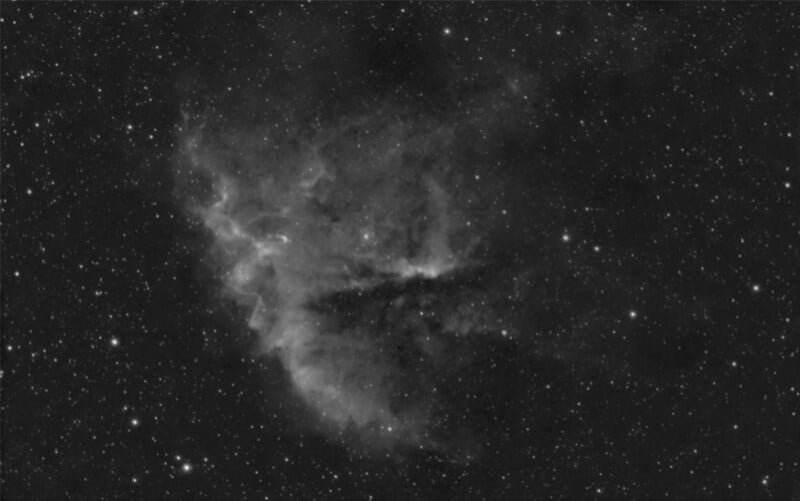
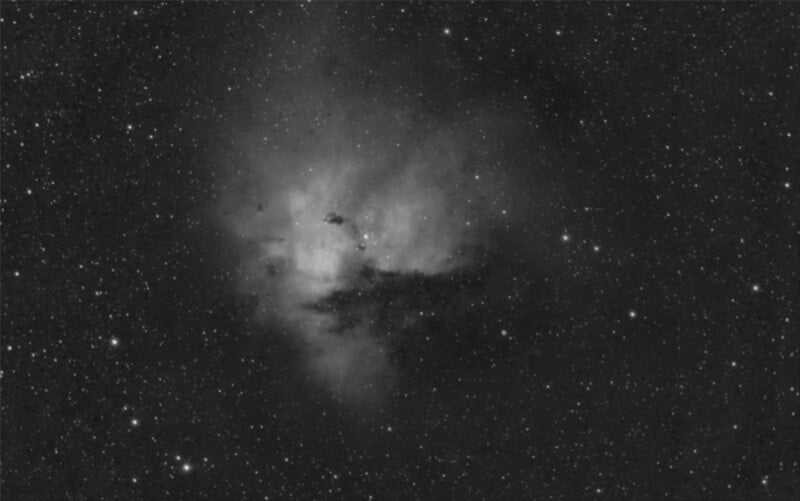
However, since his camera is grayscale, Metsavainio, like professional astronomical image processors, has a bit of room to play. While he can opt for accurate colors, he can also tweak it a bit, much like astrophysicists do with the Hubble Space Telescope images.
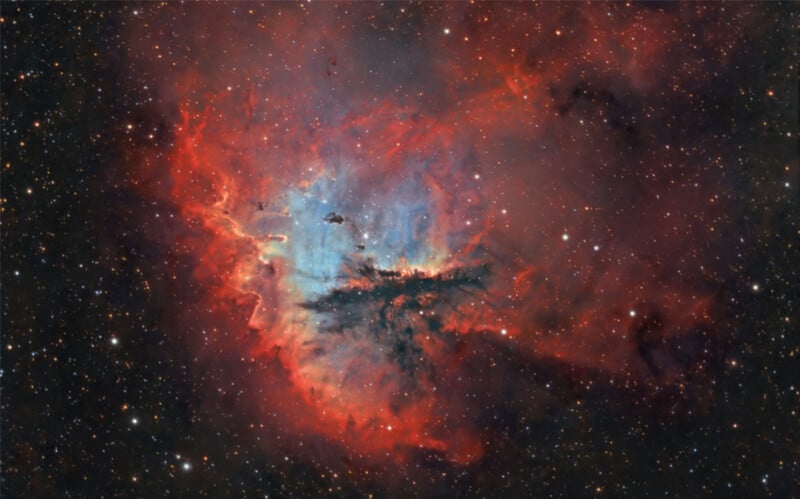
For the “Hubble Palette,” three channels are connected like this: the H-alpha channel is green, S-II is red, and O-III is blue.
“The result separates the different emission elements in the object, the golden yellow hues come from hydrogen and sulfur, I like the beauty of this palette,” the photographer says.
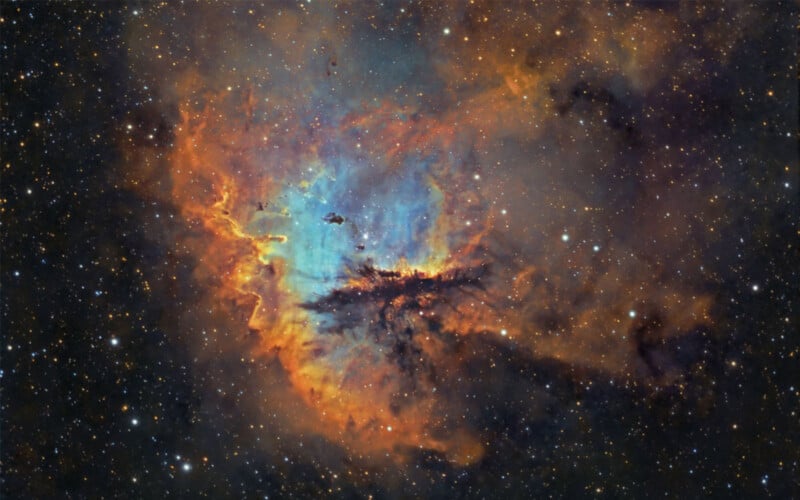
How Astrophotography Technology Changed Over the Past 30 Years
J-P has done astronomical photography for nearly 30 years and has used various instruments, some “bad, better, and even some good.”
While his gear has changed a lot over the years, he says the workflow is pretty much the same — “complex” — even as he has shifted to a dedicated astronomical camera system.
His new system has enabled him to capture many different images, though. In the case of WR 134, his older system struggled with the target due to its distance, size, and dimness. He can capture more light with a dedicated astronomical camera, which makes a massive difference.
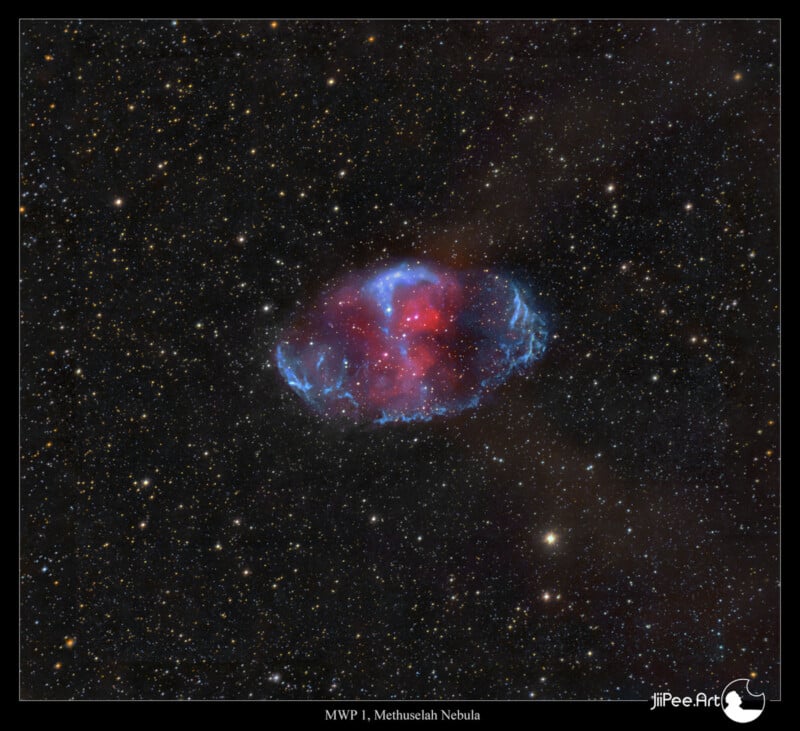
However, his camera’s ability to reach farther into space comes with costs. Beyond the obvious monetary one, a longer focal length makes Metsavainio’s work more difficult.
“Long focal length astronomical imaging is one of the most challenging forms of photography since the things get exponentially more difficult, when the focal length increase. The tolerances are extremely small if high-quality results are wanted.”
There are also variables when doing astrophotography, even when sky conditions are good, and the longer the focal length, the more these minor changes, and factors outside the photographer’s control matter.
“When focal length increases, the mechanical (and optical) errors will become more visible since the whole imaging process is happening on a moving platform, the Earth,” he explains.
Beyond temperature deltas — temperature shifts at night change how light travels and can cause focus errors — Metsavainio also deals with mechanical errors. His mount has a maximum mechanical error under four arcseconds (one arcsecond is 1/3,600 degrees).
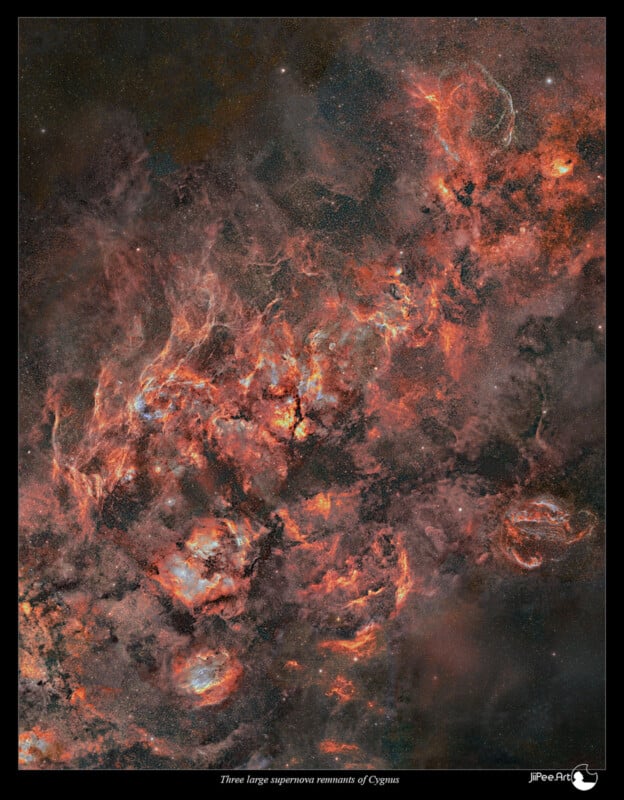
“It’s very little, but at the same time, it is too much,” the photographer says. To compensate for these mechanical errors, astrophotographers have different options, including using a second camera with a specialized prism that analyzes the movements of a single star. Metsavainio uses something a little different: an active optics unit. The SX-AO keeps the guidance star in one place and does so “really fast and many times per second.”
Each time he goes out to shoot, Metsavainio must also calibrate his equipment. It’s tedious and must be done under a real starfield in good conditions to achieve the best results.
A Long Love for Astrophotography Started With a Simple Backyard Telescope at Christmas
There are many hoops to jump through to do astrophotography, each more challenging than the last. But for J-P, it’s worth it because space speaks to him at a profound level.
It all started when he bought a small backyard telescope for Christmas for his wife, Anna, about 30 years ago.
“We went out together to look [through the telescope] and we saw Saturn and its ring structure.”
The pale yellowish dot in the sky turned into a whole new world in front of our eyes, which was a mind-blowing moment. Naturally, we both knew what Saturn looked like in the pictures, but seeing it yourself, just hanging there in the middle of emptiness, was something totally different.”
As a visual artist, I wanted to capture this vision, moment, and feeling, and I guess I am still trying to do that.”
![]()
How to Get Started in Astrophotography
People frequently ask J-P what the best gear is for those who want to try astrophotography.
“I have the same answer to everyone: buy a decent DSLR, a good quality fixed 20mm or shorter lens, and a sturdy tripod.”
Metsavainio admits that astrophotography has a steep learning curve, but he’s adamant that people don’t need as much fancy equipment as it seems.
“[Astrophotography] is much more about knowledge and patience than just tools. There are stunning photos of the night sky, with or without the landscape, taken with very basic photography setups.”
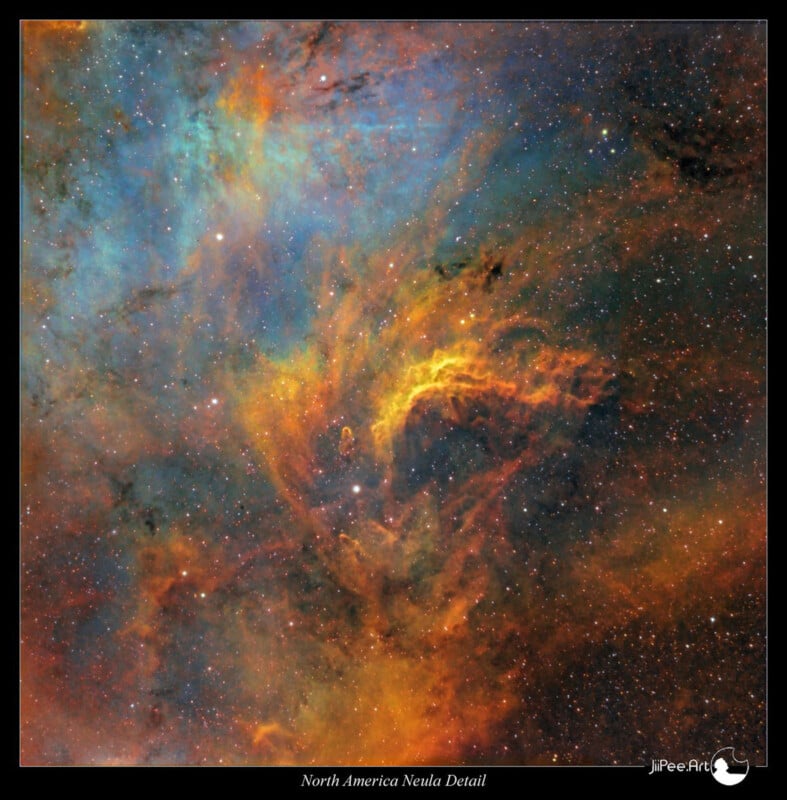
But Metsavainio has plenty of practical advice, too. Shoot everything in RAW and become very familiar with calibrating the specific equipment you have.
“Calibration will remove imperfections from images, like vignetting, dust, hot pixels, etc.”
“A flat frame is needed to get rid of those imperfections in the image, After the set of photos is taken from the night sky, aim the camera to a flat lit surface, like a white laptop screen, and take couple of dozen shots with same settings as the actual photos so that the histogram is about 50 percent full. You’ll need to shoot new flat image set after every new imaging session,” the photographer explains.
Photographers will also need a set of bias images. These are taken with a covered lens and the shortest possible exposure time.
“Cover the lens with aluminum foil, the plastic cap is transparent to infrared. After that, take couple of dozen bias images. Bias images are needed to determine the zero level of the imaging chip. It varies between cameras, even they are same brand and model. You can use the same bias info for a long time,” Metsavainio says.
As for software, the astrophotographer recommends a free app called Deep Sky Stacker.
Besides this, much else requires a dark sky, practice, and experience. Learning how to focus manually, figuring out which settings work best for a specific situation, and figuring out a reliable post-processing workflow is not simple, but it is very doable.
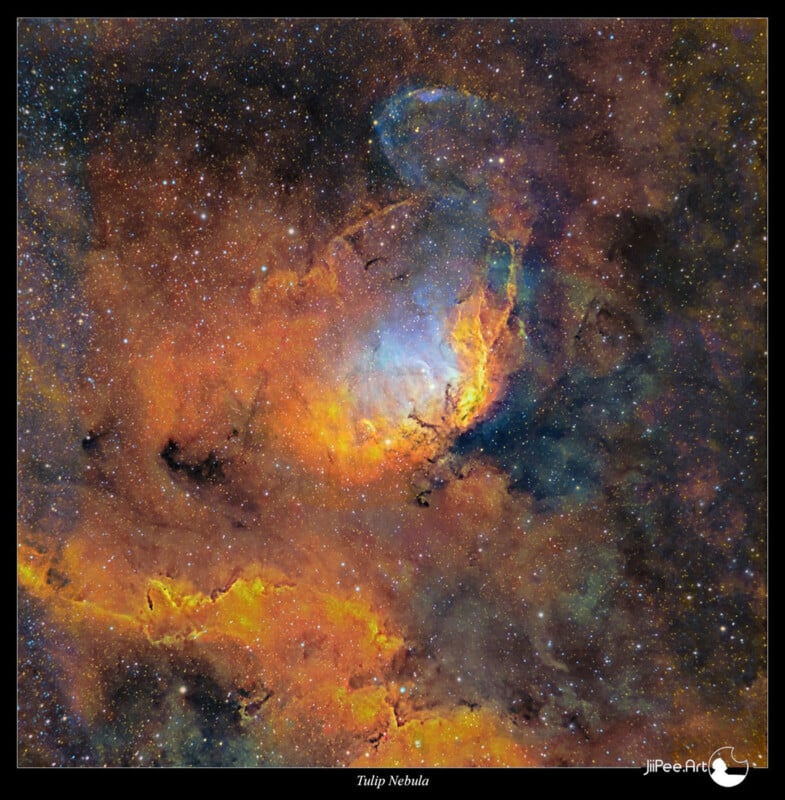
Astrophotography Is Worth the Effort to Learn
“Photos are made by photographing, not by any software,” Metsavainio explains. While he uses specialized software to bring everything together, the actual act of capturing the images is where the joy is found. With his camera, the Finnish photographer can peer deep into the Universe and bring its beauty back for everyone else to enjoy.
“I work as a visual artist, but my photos are fulfilling the rules of scientific imaging. Even though I don’t have any scientific ambitions, my photos are used in science. There are many scientific projects in astronomy using my material as a part of research papers they publish.”
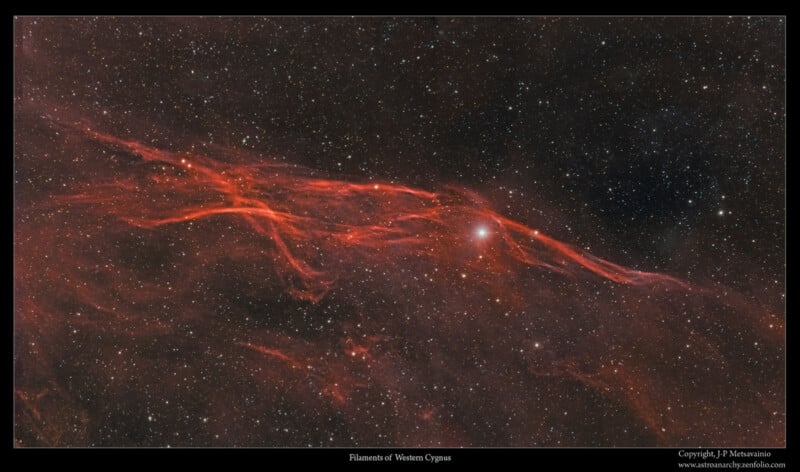
When balancing art and science, Metsavainio is an artist at heart.
“The art part is everywhere, its ability to see things a little differently or see the beauty where it’s normally not seen,” he explains.
Sometimes he chooses targets because he likes how they look, spending days, weeks, and sometimes even years to capture beautiful images of stunning cosmic objects that, in some cases, have never even been observed before.
While some of his targets are scientifically relevant, others he photographs just because he wants to. Although multi-billion dollar space telescopes can capture images in space that Metsavainio certainly cannot, scientists and astrophysicists look at things differently than him.
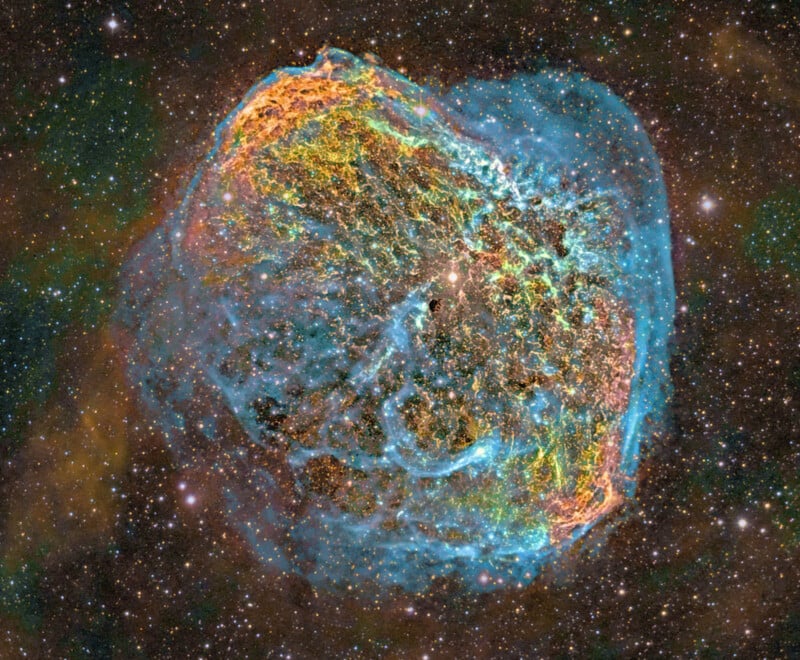
“They will never spend a million-dollar hour just for revealing some cosmic beauty and poetry. That is my job,” the photographer says. “I can spend years with one image to get it as I want to show and see it. Large observatories can’t do that.”
“Bottom line, I can’t take pictures like those technical marvels can, and they can’t take pictures like I do,” J-P Metsavainio concludes.
Image credits: All images © J-P Metsavainio. Prints are available here.
